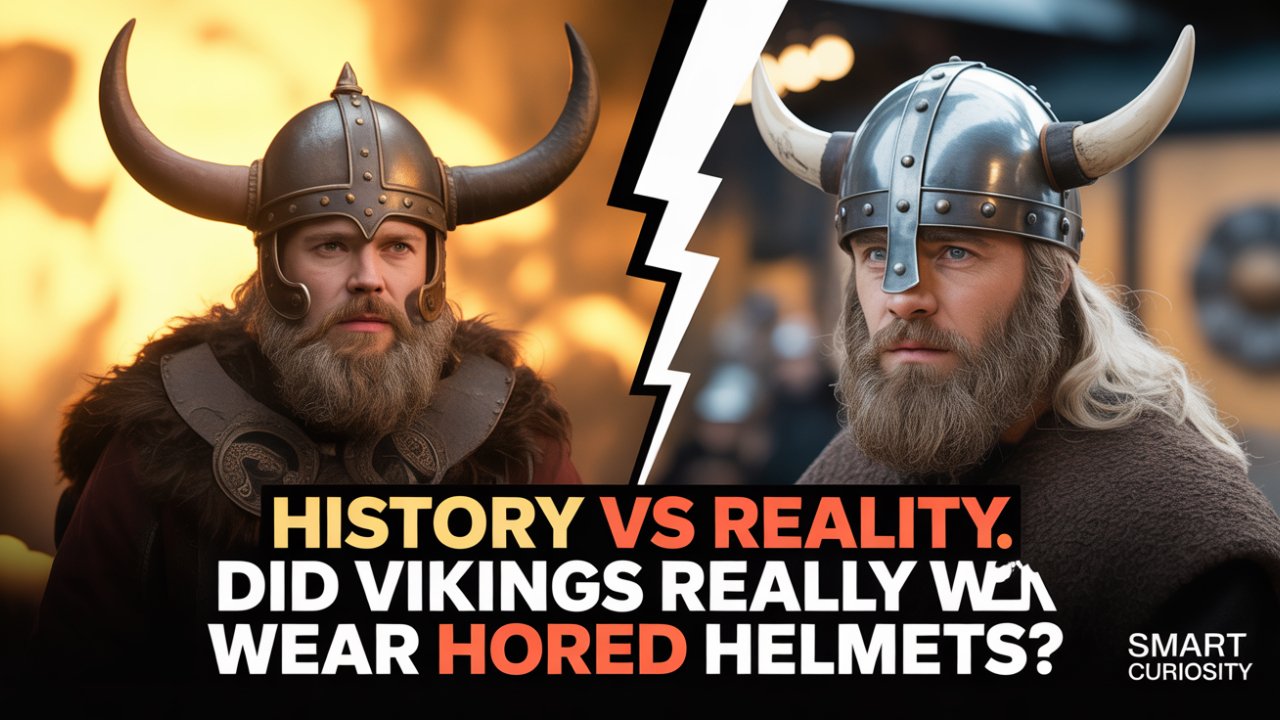Go ahead and close your eyes for a second. Picture a Viking. What pops into your head? I’m willing to bet you see a huge figure with a wild beard, a scary-looking axe in one hand, and a shield in the other. He’s standing on the front of a longship, staring down a cold, grey sea. And on his head, against a stormy sky, is a helmet… adorned with a pair of sharp, curving horns.
This image is one of the most powerful symbols in history. It’s the visual shorthand for brutal strength and the fury of the Northmen. We see it everywhere: on football helmets, in Hollywood blockbusters, in cartoons, and in video games. The image is so burned into our minds that picturing a Viking without a horned helmet feels… wrong. It’s the one thing that seems to separate them from every other warrior. This horned berserker is the Viking we all think we know. He is iconic. He is terrifying. And he is a complete fraud.
So, what if I told you that this iconic image, the single most famous picture of a Viking warrior, is a total lie? That it’s a fantasy based on zero archaeological evidence and a major misunderstanding of history? In this video, we’re going to take an axe to that myth and chop it in two. We’re going on a journey to debunk the biggest misconception about the Norse people. We’ll dig through a thousand years of dirt, look at the cold, hard iron of reality, and expose the surprising, 19th-century origin of this massive lie.
And then, once the fantasy is out of the way, we’ll show you what their actual battle helmets the ones that saw the terror of a shield wall and tasted the salt of the North Sea really looked like. The truth is way more practical, much rarer, and honestly, a lot more interesting than the fiction.
Before we can take this myth apart, we have to respect its power. The horned helmet isn’t just some simple mistake; it’s a cultural phenomenon. It has stuck around for over 150 years, seeping into every corner of pop culture. Think about it. The Minnesota Vikings NFL team has horns on their helmets, seen by millions every week. In the comics, the lovable but fierce character Hägar the Horrible is never spotted without his. From classic cartoons like “What’s Opera, Doc?” where Elmer Fudd chases Bugs Bunny in full Viking gear, to modern games like Skyrim, where the classic “iron helmet” is a horned one, you just can’t escape it.
This image has become a symbol that has detached from its original meaning and now just screams “Viking.” You don’t need a longship or a beard; just show a helmet with horns, and everyone gets the reference. It’s an incredibly efficient piece of visual shorthand. It suggests wildness, a link to nature through animal horns, and a raw, untamed ferocity. The horns add a silhouette that is undeniably dramatic and intimidating. A simple, round helmet is functional; a horned helmet is pure theater.
And that theatricality is exactly why it’s survived. It just looks cool. It plays into a romantic vision of the Viking Age as a time of larger-than-life heroes. But history doesn’t care about what looks cool. It cares about what’s true. And to find that truth, we can’t look at Hollywood or sports logos. We have to look at the ground beneath our feet. We have to ask the most basic question of all: where’s the evidence? After more than a century of digging up Viking settlements, graves, and battlefields, what have archaeologists actually found? The answer to that question is where the myth completely falls apart.
When it comes to historical truth, archaeology is the gold standard. It’s the physical, tangible proof of how people actually lived and died. Written accounts can be biased and sagas can be exaggerated, but an artifact dug out of the ground is a direct message from the past. So, if Vikings really charged into battle with horned helmets, we’d expect to find them everywhere. We’d find them in the graves of rich chieftains, buried with their best stuff. We’d find them lost in the mud of old battlefields. We’d find bits and pieces of them all over the place.
But here’s the stark, simple truth: archaeologists have never, not once, found a Viking Age helmet with horns on it. Let that sink in. Out of the thousands of Viking graves that have been excavated, not a single one supports this famous image. The archaeological record is completely silent. This isn’t a debate among historians; it’s a settled fact. The horned helmet is a phantom.
What the record does give us is something way more valuable, because it’s real. To date, only one single, nearly complete Viking helmet has ever been discovered on the entire planet. It’s so important that it deserves our full attention. It’s known as the Gjermundbu helmet.
Found in 1943 in a chieftain’s burial mound near Gjermundbu, Norway, this helmet dates to the 10th century, right in the middle of the Viking Age. It was buried alongside other high-end warrior gear, like a chainmail coat and a beautiful sword. This was the equipment of a powerful leader. And the helmet that protected his head looks absolutely nothing like the popular image.
The Gjermundbu helmet is a masterpiece of practical, brutal efficiency. It’s a type of helmet known as a “spangenhelm,” which was common in Europe at the time. It was made from a framework of iron bands, with four iron plates riveted together to form a rounded bowl for the head. There’s no dramatic crest, no wings, and most importantly, no horns. What it does have is a guard for the face. Coming down from the brow is a thick iron “nasal” guard to protect the nose, attached to a striking “spectacle” guard that circles the eyes. The whole look is intimidating and mask-like, but it’s a functional intimidation, born from the grim reality of battle.
While the Gjermundbu helmet is our only complete example, it’s not our only clue. Other helmet fragments found in Denmark, England, and even modern-day Ukraine all point to similar designs: practical, hornless bowls of iron. The pattern is the same across the entire Viking world. Their helmets were tools for war, not stage props.
So why is the evidence so rare? Why just one complete helmet? Well, a few reasons. First, iron was incredibly valuable. A helmet took a lot of ore and a highly skilled blacksmith to make, so they were rare and expensive items, likely only owned by chieftains and their professional warriors. Second, valuable things like helmets weren’t usually buried. They were passed down from father to son or, if they got damaged, were melted down and turned into something else. The Gjermundbu burial was a rare exception. Finally, iron rusts. After a thousand years in the ground, most iron just corrodes away to nothing. Finding one at all is an archaeological miracle.
Okay, let’s step away from archaeology for a second and just use some common sense. Imagine you’re a Viking warrior in a shield wall the cornerstone of their battle tactics. It’s an interlocking wall of shields and spears. It’s a grinding, shoving, stabbing mess. Now, imagine you have two big horns sticking out of your head.
In the crush of the shield wall, those horns would be a huge problem. They’d get tangled up with the shields and weapons of the guys next to you, messing up the tight formation. On the crowded deck of a longship, they’d be a clumsy nuisance, snagging on ropes and rigging.
Now picture the enemy charging at you. A warrior with a sword or axe isn’t going to be scared of your horns; they’re going to see a giant, convenient target. Horns on a helmet break the single most important rule of armor design: deflecting blows. A good helmet is round or curved for a reason. When a sword hits a curved surface, it’s more likely to slide off, spreading out the force.
A horn does the exact opposite. It’s a perfect catching point. An enemy’s axe could hook onto the horn, and with a sharp twist, that force is transferred violently to your head and neck. It could break your neck or at least rip the helmet right off, leaving you exposed. An enemy could even grab the horn with their hand, giving them complete control over your head. It basically turns your own armor into a handle for your enemy. In short, for combat, it’s a catastrophically stupid idea.
The real Viking helmet, the Gjermundbu helmet, is a perfect example of smart design. Its round top makes sword blows slide off. Its spectacle guard protects the face without blocking vision. It’s a piece of tech shaped by the brutal math of life and death. Horns have no place in that equation. The Viking warrior was a pragmatist. They used what worked. And horns, for all their flair, just didn’t.
Now, here’s where the story gets a really fascinating twist. Because if you said that horned helmets were never worn in Scandinavia, you’d be wrong. They definitely were. The critical detail is when.
In the National Museum of Denmark, you can see two incredible artifacts: the Viksø helmets. Found in a bog in 1942, these two identical bronze helmets have huge, curving horns, almost like a bull’s. They are stunning, powerful, and undeniably horned. There’s just one tiny problem: they date to the Nordic Bronze Age, around 900 BCE. That’s nearly 2,000 years before the first Viking longship ever sailed. Saying the Viksø helmets are Viking helmets is like saying a Roman legionary’s helmet is the same as one from World War I. The time gap is massive.
On top of that, these Bronze Age helmets almost certainly weren’t used for fighting. They’re made of thin bronze and offer very little protection. Their purpose was almost definitely ceremonial. They were probably worn by priests or chieftains during religious rituals as symbols of power. The horned design itself might have come from the ancient Near East, spreading to Scandinavia through trade routes.
We see other hints of horned headgear in art from around the Viking Age, but it’s always in the context of myths or rituals, not war. For instance, a tapestry from the famous Oseberg ship burial shows figures in a procession, and some appear to be wearing horned helmets. But again, this is seen as a religious scene, maybe depicting gods like Odin or priests acting as them.
These weren’t battle helmets. They were crowns. They were ritual masks. The average Viking farmer or raider would have had about as much access to one as a modern person has to the Crown Jewels. So what we have is a case of mistaken identity across millennia. Real horned helmets existed, but they belonged to a different people, a different time, and had a completely different purpose. So, if the real Vikings didn’t wear them, where on Earth did this myth come from? The answer isn’t in ancient history, but in a much more recent era of opera and art.
For centuries after they were gone, Vikings were mostly remembered as bloodthirsty barbarians. But in the 19th century, that started to change with the cultural movement of Romanticism. People began looking back at medieval history not as a dark age, but as a source of national pride. In Scandinavia and Germany, scholars and artists rediscovered the Old Norse sagas and saw in the Vikings a reflection of virtues they admired: strength, bravery, and a love of freedom.
This romantic revival needed a powerful visual identity. It needed a hero. And that hero needed a costume. In the 1820s, a Swedish artist named Gustav Malmström illustrated a famous collection of poems called Frithiof’s Saga, where he drew his Viking heroes wearing helmets with small, wing-like horns. This was one of the first times a Viking warrior was paired with non-historical headgear.
But the man who really cemented the myth in the public’s mind wasn’t an artist or a historian. He was a composer: the German musical genius Richard Wagner.
Wagner was obsessed with Norse and Germanic mythology. His masterpiece was a cycle of four massive operas called Der Ring des Nibelungen, or “The Ring of the Nibelung.” First performed in 1876, it was a huge cultural event. When it came time to stage this epic, the costume designer, Carl Emil Doepler, had to create a visual world for all these gods and heroes. Drawing on the romantic ideas of the time, and likely mistaking ancient ceremonial figures for warriors, Doepler made a fateful choice. He designed spectacular, dramatic helmets for his characters. Some had eagle wings. And others, fatefully, had bull horns.
These costumes were never meant to be historically accurate. They were meant to be theatrical to look powerful from the back row of a huge opera house. And it worked. The image of the horned Wagnerian hero became an international sensation. The opera was a smash hit, and its imagery was everywhere. The horned helmet had gone mainstream. From there, the myth just took on a life of its own. It was so visually appealing, so much more dramatic than the simple reality, that it became unstoppable. The lie was told so well that it completely replaced the truth. The quiet, archaeological fact of the Gjermundbu helmet stood no chance against the thunderous, operatic power of Wagner’s horned singers.
So, let’s get the opera singer out of our heads and go back to that 10th-century Norse chieftain being buried at Gjermundbu. We know what his helmet looked like: a practical, hornless iron bowl with face protection. Now let’s put that helmet in context with what a well-equipped Viking warrior actually wore.
The most valuable piece of armor, even more than a helmet, was a coat of mail, called a byrnie. This was a shirt, usually thigh-length, made of thousands of interlinked iron rings. A byrnie could take months to make, so it was incredibly expensive. Like the helmet, it was reserved for the elite kings, jarls, and their professional bodyguards.
The most common piece of defensive gear for every Viking, rich or poor, was the shield. Viking shields were round, made of wood, and about three feet across. They were often covered in leather and painted with bold designs. The shield wasn’t just for blocking; it was an active weapon, used to push and create openings.
For weapons, the spear was the most common, followed by the axe. Swords were high-status weapons, a sign of great wealth. And the Viking axe wasn’t usually a massive, double-bladed fantasy weapon. It was typically a light, fast, single-bladed axe on a long handle, a deadly evolution of a simple wood-cutting tool.
Now, put the real Viking helmet back into this picture. An iron spangenhelm, a coat of mail, a brightly painted shield, and a spear or axe. This is the image of the historical Viking warrior. It’s an image of brutal practicality. Every single piece of gear is designed with a purpose, perfected by generations of conflict. There are no useless decorations. Their survival depended on their gear working. The real Viking look is less opera and more grim, functional engineering. And in its own way, that’s far more intimidating than any pair of horns.
So, did Vikings really wear horned helmets? The answer is a clear, resounding, and historically undeniable “no.” This iconic image, as powerful as it is, is nothing more than a ghost a 19th-century fantasy that has haunted our view of the past for way too long.
The myth of the horned helmet has no basis in archaeology. The horns would have been a fatal flaw in the reality of Viking combat. The origin of the myth isn’t in 10th-century Norway, but in 19th-century German opera houses, thanks to costume designers like Carl Emil Doepler, who chose drama over accuracy. And finally, thanks to the incredible Gjermundbu helmet, we know what real Viking helmets looked like: masterpieces of medieval engineering, designed for one thing only: to keep a warrior alive.
The real story of the Viking helmet is a perfect lesson in how history can be misunderstood and rewritten. It reminds us to always question the popular image and look for the real evidence. So the next time you see a cartoon or a sports team with a horned helmet, you can smile. Because you know the real story. The truth isn’t a warrior with horns. It’s a far more complex and fascinating tale of archaeology, practicality, and the surprising power of opera.
If you enjoyed destroying that myth with us, do us a favor and hit that like button. Make sure you subscribe and turn on notifications so you don’t miss our next dive into the history you thought you knew. And now we want to hear from you. What are some other historical myths you’ve always wondered about? Let us know in the comments below, and your idea might just become our next investigation. Thanks for watching.





